Smart flying cameras revolutionize construction site management, offering you real-time monitoring and enhanced security. They track progress instantly, improve worker safety, and provide cost-effective aerial inspections. You'll benefit from accurate documentation, environmental impact monitoring, and efficient resource management. These cameras streamline communication among teams and aid in dispute resolution with clear visual evidence. By implementing this technology, you'll boost project efficiency, reduce risks, and stay ahead of potential issues. The thorough oversight and data-driven insights provided by smart flying cameras can transform how you approach construction management. Discover how this innovation can elevate your projects to new heights.
Enhanced Site Security
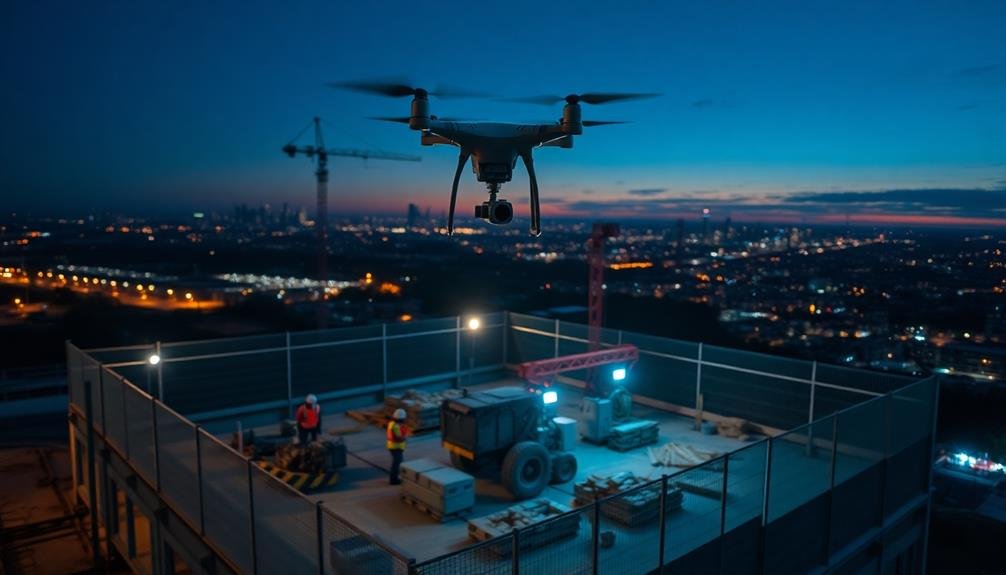
Watchful eyes in the sky revolutionize construction site security. Smart flying cameras offer you unprecedented surveillance capabilities, enabling real-time monitoring of your entire project area. These drones can detect unauthorized personnel, trespassers, or potential thieves, alerting you instantly to any security breaches.
You'll benefit from 24/7 coverage, as these cameras can operate in low-light conditions and challenging weather. They're equipped with high-resolution cameras and thermal imaging technology, allowing you to spot intruders even in darkness or fog. You can program them to follow specific patrol routes or respond to motion sensors, ensuring thorough site protection.
These smart drones also serve as a powerful deterrent. Visible aerial surveillance discourages theft and vandalism, reducing your insurance costs and potential losses. You'll have recorded evidence of any incidents, which can be essential for investigations or legal purposes.
Moreover, you can integrate these flying cameras with your existing security systems. They'll work in tandem with ground-based cameras, access control systems, and security personnel, creating a multi-layered defense strategy.
This cohesive approach greatly enhances your site's overall security, giving you peace of mind and protecting your valuable assets and equipment.
Real-Time Progress Tracking
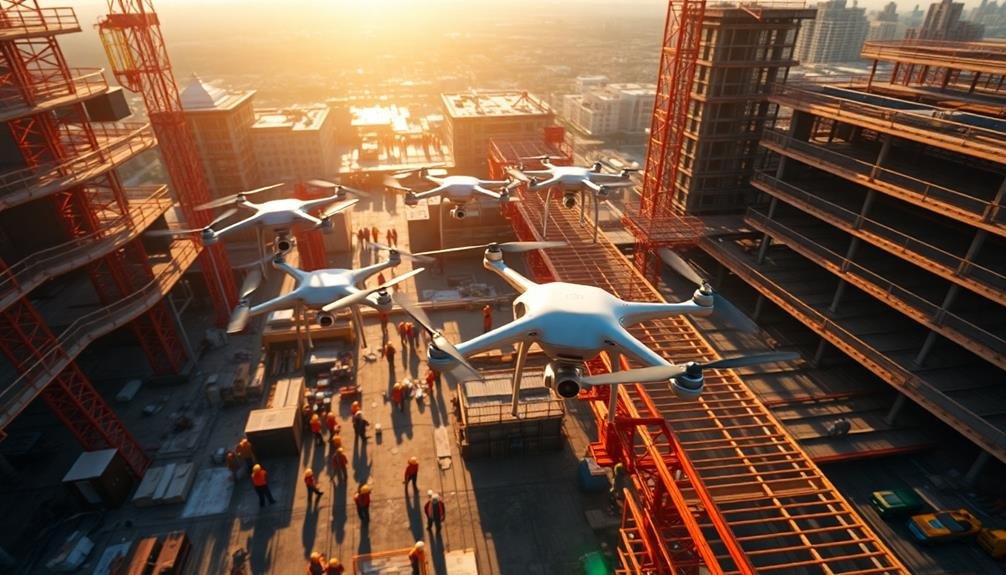
Smart flying cameras revolutionize how you track construction progress, providing instant project status updates at your fingertips.
You'll quickly detect construction delays, allowing for swift adjustments to keep your project on schedule.
With real-time data, you can improve scheduling accuracy, optimizing resource allocation and ensuring timely project completion.
Instant Project Status Updates
Three key benefits emerge from using smart flying cameras for instant project status updates.
First, you'll have immediate access to thorough site information. These cameras capture high-resolution images and videos, allowing you to assess progress, identify potential issues, and make informed decisions without physically visiting the site.
Second, you'll enhance communication among stakeholders. Project managers, clients, and team members can access real-time updates through a centralized platform, ensuring everyone's on the same page. This transparency reduces misunderstandings and streamlines decision-making processes.
Lastly, you'll improve project documentation. Smart flying cameras automatically generate detailed reports, including time-stamped images and data. This creates an accurate historical record of the project's evolution, which is invaluable for dispute resolution, quality control, and future planning.
Detect Construction Delays Quickly
With smart flying cameras, you'll spot construction delays before they become major setbacks. These aerial devices continuously monitor your site, capturing real-time data on project progress. By comparing current site conditions to your planned schedule, you can quickly identify areas falling behind.
Smart cameras use AI to analyze footage, flagging potential issues like material shortages, equipment breakdowns, or insufficient workforce. You'll receive alerts when progress deviates from the plan, allowing for swift corrective action. This proactive approach helps maintain project timelines and budgets.
| Delay Type | Detection Method | Action Taken |
|---|---|---|
| Material Shortage | Inventory tracking | Rush order placement |
| Equipment Failure | Anomaly detection | Immediate repair/replacement |
| Workforce Shortage | Headcount analysis | Hire additional workers |
| Weather Disruption | Weather data integration | Schedule adjustment |
Improve Scheduling Accuracy
Real-time progress tracking revolutionizes construction scheduling accuracy. With smart flying cameras, you'll have access to up-to-the-minute data on your project's status. This information allows you to make informed decisions quickly, adjust timelines as needed, and allocate resources more efficiently.
By implementing aerial surveillance, you'll gain a thorough view of your construction site. This bird's-eye perspective enables you to:
- Identify bottlenecks and potential delays before they become significant issues
- Compare actual progress to planned schedules, allowing for immediate adjustments
- Optimize resource allocation based on real-time needs and priorities
You'll be able to update your project timeline with precision, ensuring that all stakeholders are on the same page. This improved accuracy leads to better coordination among subcontractors, reduces conflicts, and minimizes costly delays.
Smart flying cameras also provide valuable historical data, allowing you to analyze patterns and trends in your construction processes. You can use this information to refine your scheduling methods for future projects, continuously improving your accuracy and efficiency.
Improved Worker Safety
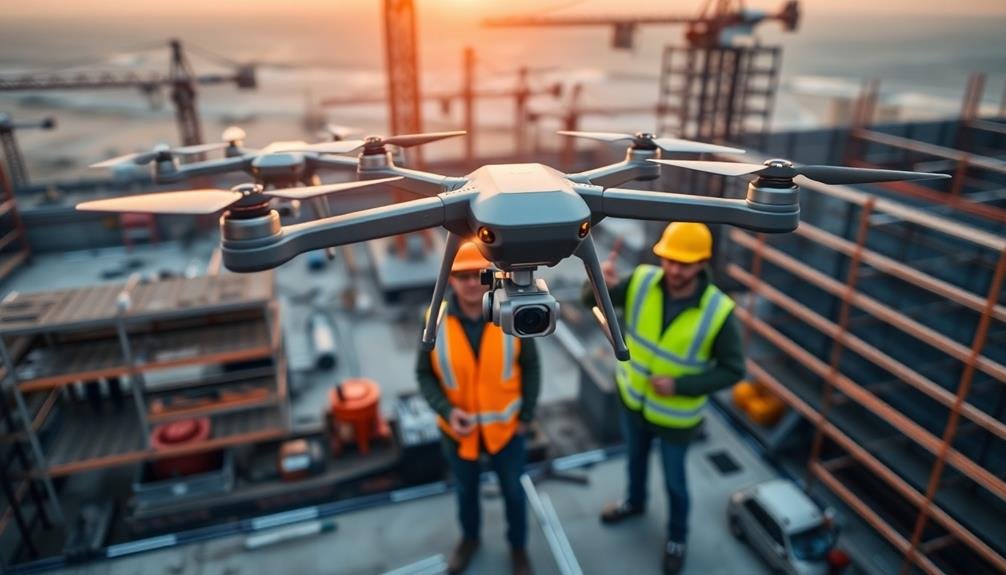
You'll enhance worker safety on construction sites with smart flying cameras that offer real-time hazard detection.
These airborne sentinels can spot potential dangers before they escalate, allowing for swift intervention.
Real-Time Hazard Detection
Safety takes center stage with smart flying cameras' real-time hazard detection capabilities. These airborne sentinels continuously scan your construction site, instantly identifying potential dangers that might escape human observation.
You'll receive immediate alerts about hazardous conditions, allowing you to take swift action and prevent accidents before they occur.
Smart flying cameras equipped with advanced AI algorithms can detect a wide range of safety risks, including:
- Unsafe work practices, such as employees not wearing proper protective equipment
- Structural instabilities or weaknesses in scaffolding or temporary supports
- Dangerous equipment placement or unauthorized access to restricted areas
You'll benefit from the cameras' ability to monitor large areas simultaneously, providing a thorough view of your entire construction site.
They can detect subtle changes in the environment that might indicate impending danger, such as shifts in terrain or unexpected obstacles.
With this real-time information at your fingertips, you can make informed decisions quickly, prioritize safety interventions, and allocate resources more effectively.
Accident Prevention Measures
Three key accident prevention measures emerge when using smart flying cameras to improve worker safety on construction sites. First, you'll benefit from real-time monitoring of worker behavior and equipment usage. The cameras can detect unsafe practices or improper use of machinery, allowing supervisors to intervene immediately. Second, you'll have enhanced site surveillance, identifying potential hazards before they cause accidents. This proactive approach enables you to address issues promptly, reducing the risk of injuries. Third, you'll gain valuable data for safety training and protocol improvements.
Here's a breakdown of these measures and their impacts:
| Measure | Implementation | Impact |
|---|---|---|
| Real-time monitoring | Continuous aerial surveillance | Immediate intervention |
| Enhanced site surveillance | Regular site scans | Proactive hazard mitigation |
| Data-driven training | Analysis of footage | Improved safety protocols |
| Automated alerts | AI-powered detection | Rapid response to dangers |
| Remote supervision | Live video feeds | Increased oversight |
Cost-Effective Aerial Inspections
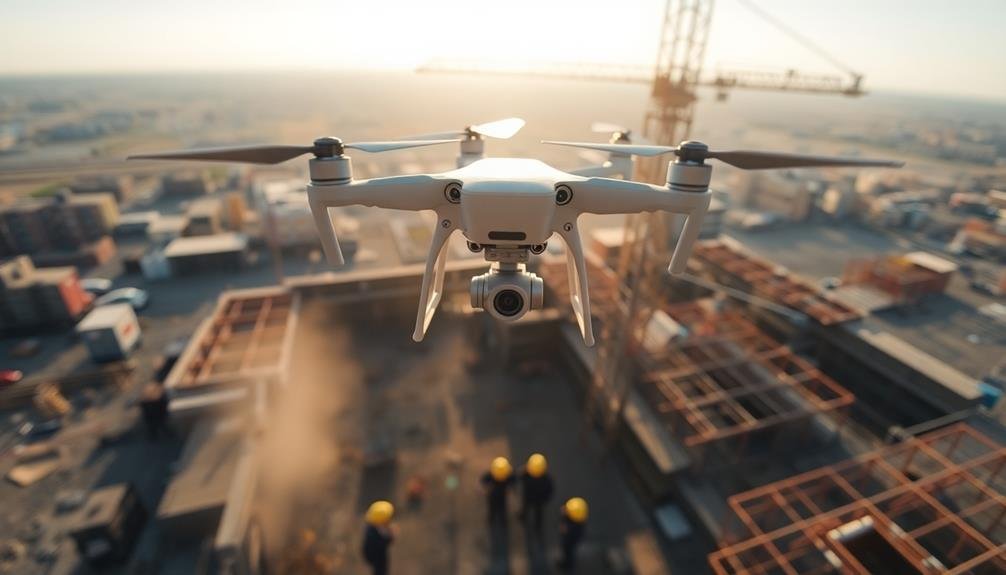
Drones offer a cost-effective solution for aerial inspections of construction sites. You'll find that using smart flying cameras can greatly reduce the time and resources needed for site surveys and progress monitoring.
By deploying drones, you're able to capture high-resolution imagery and video footage of your entire project area in a fraction of the time it would take using traditional methods.
These aerial inspections provide you with:
- Real-time data on project progress
- Early detection of potential issues or safety hazards
- Accurate measurements and 3D modeling capabilities
You'll save money on labor costs by eliminating the need for manual inspections in hard-to-reach areas. Drones can access dangerous or inaccessible locations without putting workers at risk, reducing potential liability and insurance costs.
Additionally, you'll benefit from increased efficiency as drones can quickly cover large areas and provide detailed information that might otherwise be missed.
Accurate Documentation and Reporting

Smart flying cameras not only provide cost-effective aerial inspections but also revolutionize documentation and reporting on construction sites. These devices capture high-resolution images and videos, allowing you to create detailed visual records of project progress, site conditions, and potential issues.
You'll benefit from automated data collection and processing, which streamlines the creation of accurate reports. Smart flying cameras can generate 3D models, orthomosaic maps, and volumetric measurements, giving you precise information about earthwork, stockpiles, and structural elements. This data helps you track progress against project timelines and budgets more effectively.
With these advanced tools, you can easily share real-time updates with stakeholders, improving communication and transparency. You'll have access to historical data for comparison, enabling you to identify trends and make informed decisions.
The cameras' AI capabilities can detect safety hazards, quality issues, and deviations from plans, alerting you to potential problems before they escalate.
Environmental Impact Monitoring
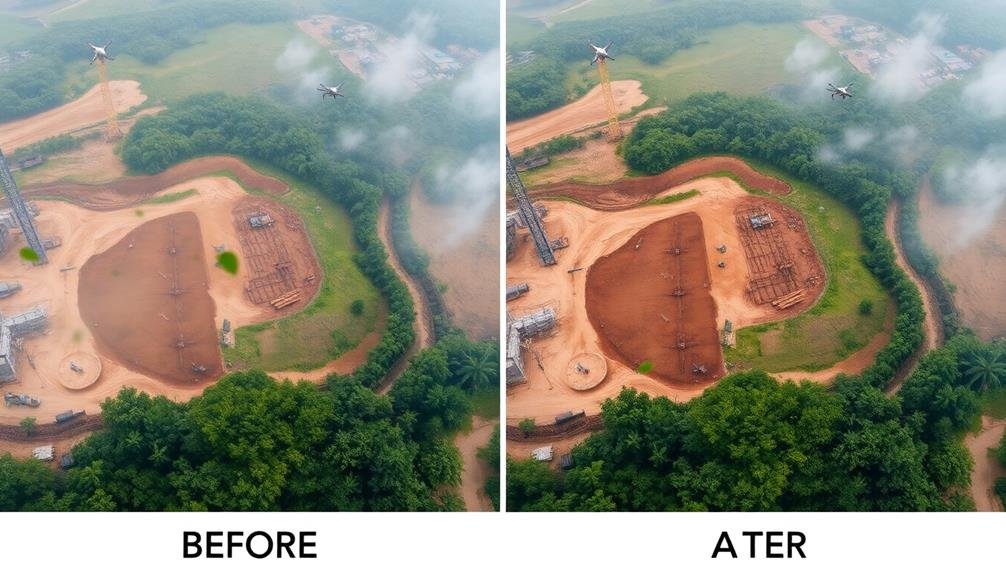
Many construction projects face increasing scrutiny regarding their environmental impact. Smart flying cameras can help you monitor and mitigate these concerns effectively. By using drones equipped with advanced sensors and imaging technology, you'll be able to assess and track various environmental factors throughout the construction process.
You can use smart flying cameras to:
- Monitor air quality and dust levels in real-time
- Detect potential contamination of nearby water sources
- Assess vegetation changes and wildlife disruption in surrounding areas
These cameras allow you to collect data on erosion control measures, waste management practices, and noise pollution levels.
You'll be able to identify potential environmental issues early on, enabling quick interventions and adjustments to your construction methods. This proactive approach helps you maintain compliance with environmental regulations and reduce the risk of costly fines or project delays.
Efficient Resource Management
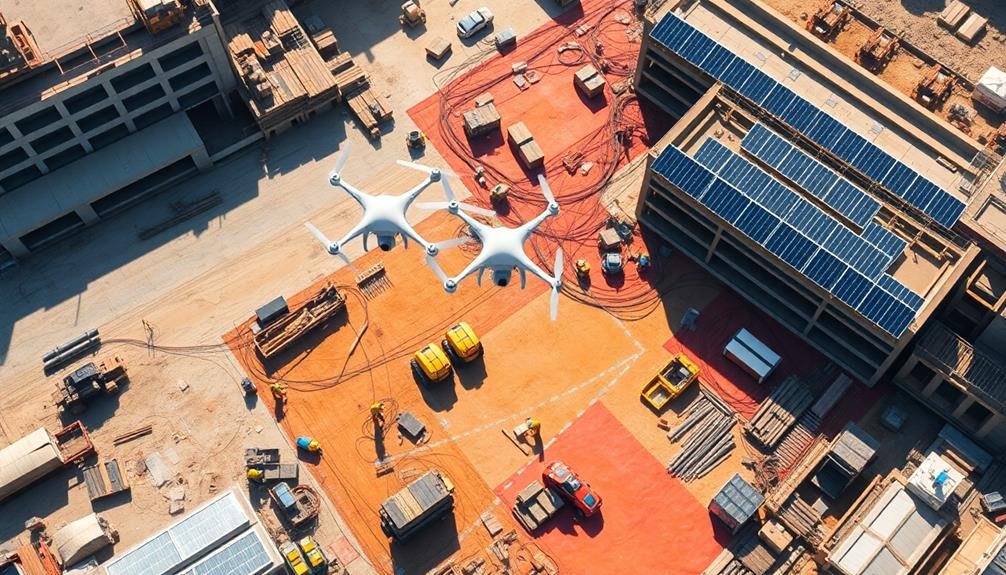
While construction projects often grapple with resource allocation challenges, smart flying cameras can revolutionize how you manage materials, equipment, and personnel on-site. These aerial devices provide real-time data on resource usage, allowing you to optimize your operations and reduce waste.
You'll gain a bird's-eye view of your entire site, helping you identify underutilized equipment or excess materials. This information enables you to redistribute resources more efficiently, saving time and money. Smart cameras can track inventory levels, alerting you when supplies are running low and preventing costly work stoppages.
By monitoring worker movements, you can identify bottlenecks and streamline workflows. You'll spot idle personnel or equipment quickly, allowing for immediate reallocation to high-priority tasks. The cameras' AI capabilities can analyze patterns over time, providing insights for better resource planning in future projects.
You can also use these devices to monitor fuel consumption and equipment maintenance needs. This proactive approach helps you schedule repairs and refueling more efficiently, minimizing downtime and extending the lifespan of your valuable machinery.
Ultimately, smart flying cameras empower you to make data-driven decisions, boosting productivity and profitability across your construction operations.
Streamlined Communication
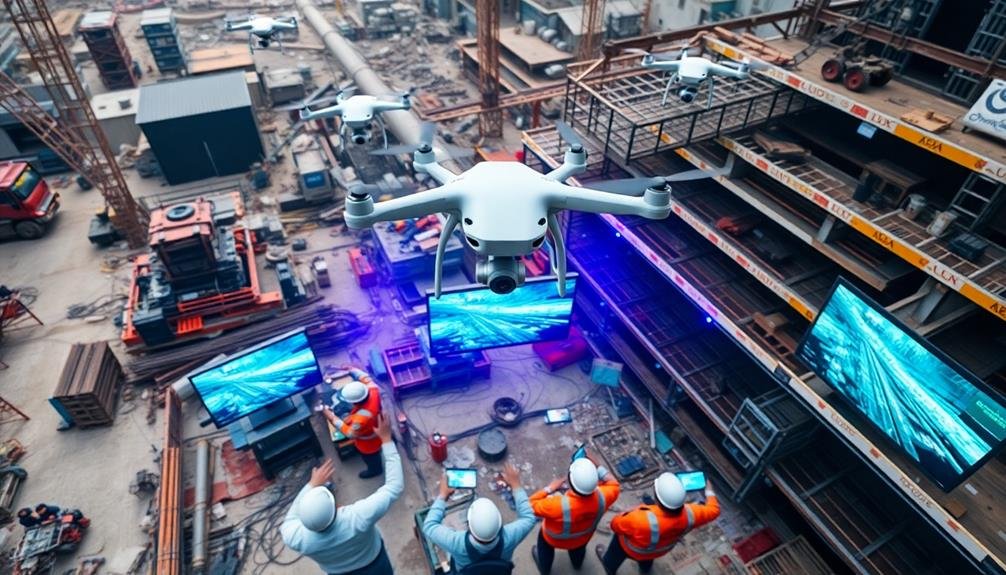
Effective communication is the backbone of any successful construction project. Smart flying cameras revolutionize how you share information on your construction site. They provide real-time visual data that's instantly accessible to all stakeholders, eliminating delays and misunderstandings.
You'll find that these aerial tools streamline your communication processes, making them faster and more efficient.
With smart flying cameras, you can:
- Share live footage with off-site team members, enabling quick decision-making
- Capture high-resolution images for detailed progress reports
- Create time-lapse videos to showcase project milestones to clients
These cameras allow you to conduct virtual site inspections, reducing the need for in-person visits and saving valuable time. You'll be able to quickly identify and address issues, ensuring that everyone's on the same page.
By integrating these devices into your communication strategy, you'll improve collaboration between teams, contractors, and clients.
Smart flying cameras also enhance safety communications. You can use them to broadcast important safety messages or demonstrate proper procedures across the site.
This visual approach to safety training and updates is more engaging and effective than traditional methods, leading to a safer work environment.
Dispute Resolution and Evidence Collection
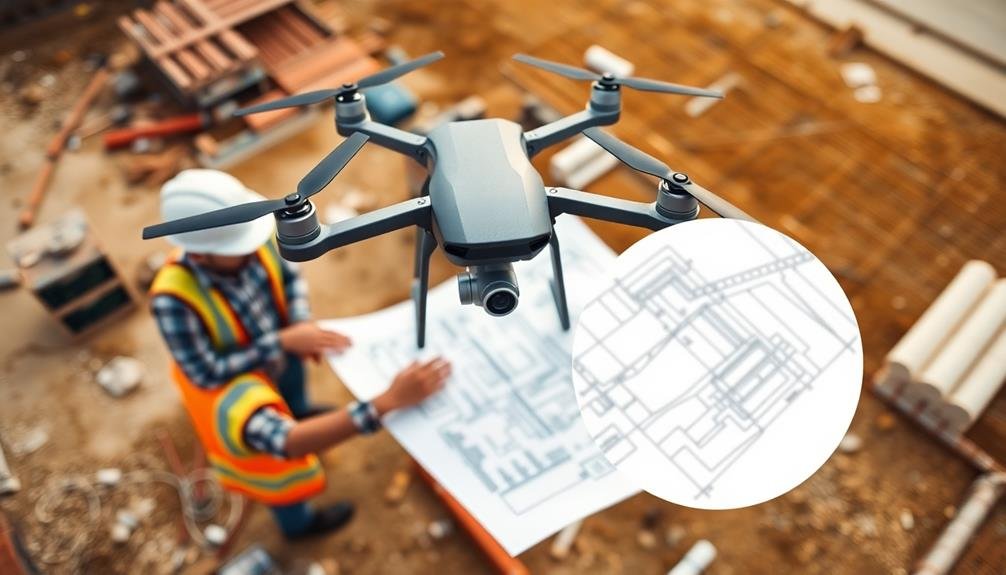
In light of potential disputes on construction sites, smart flying cameras serve as an invaluable tool for evidence collection and conflict resolution. You'll find these devices particularly useful when disagreements arise between contractors, subcontractors, or clients. By capturing high-quality footage and images of the site, you're able to provide concrete evidence of work progress, safety compliance, and potential issues.
When disputes occur, you can quickly review historical footage to determine the root cause of problems. This visual documentation helps resolve conflicts more efficiently, potentially saving time and money on lengthy legal proceedings. You'll also have a clear record of site conditions, which can protect you from false claims or accusations.
Smart flying cameras can document significant events, such as equipment deliveries, inspections, or accidents. This evidence becomes essential if you need to file insurance claims or defend against liability issues.
Frequently Asked Questions
How Do Smart Flying Cameras Handle Adverse Weather Conditions During Construction Monitoring?
You'll find smart flying cameras equipped with weatherproof designs and stabilization technology. They're programmed to adapt to wind, rain, and low visibility. If conditions become too severe, they'll automatically return to base for safety.
What Certifications or Permits Are Required to Operate Drones on Construction Sites?
You'll need FAA Part 107 certification to fly drones commercially on construction sites. Check local regulations for additional permits. Make certain you're compliant with privacy laws and obtain property owner's permission before operating drones on-site.
Can Smart Flying Cameras Integrate With Existing Project Management Software Systems?
Yes, you'll find that smart flying cameras can integrate with many project management software systems. They'll sync data, upload images, and provide real-time updates. You can easily incorporate drone footage into your existing workflow for better project oversight.
How Are Privacy Concerns Addressed When Using Drones for Construction Site Monitoring?
You'll need to address privacy concerns by implementing strict data protection policies, obtaining necessary permits, informing workers, and limiting flight paths. Use encrypted feeds, secure data storage, and follow local regulations to guarantee compliance and protect privacy.
What Is the Average Battery Life and Range of Smart Flying Cameras?
You'll find that smart flying cameras typically offer 20-30 minutes of flight time on a single charge. Their range varies, but most can cover about 1-3 miles. Battery life and range are constantly improving with new models.
In Summary
You've seen how smart flying cameras revolutionize construction site monitoring. They'll boost your security, track progress, and enhance safety. You'll save money on inspections, improve documentation, and manage resources better. These drones will help you monitor environmental impact, streamline communication, and resolve disputes. By embracing this technology, you're not just keeping up with the industry; you're staying ahead. Don't wait – start reaping the benefits of smart flying cameras today.

As educators and advocates for responsible drone use, we’re committed to sharing our knowledge and expertise with aspiring aerial photographers.




Leave a Reply